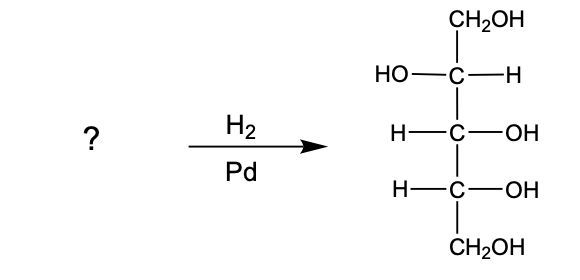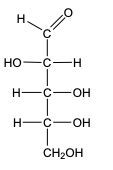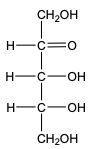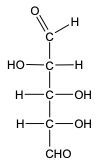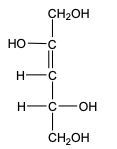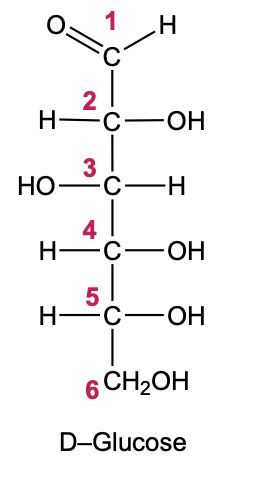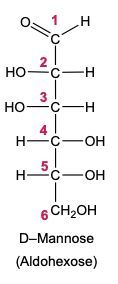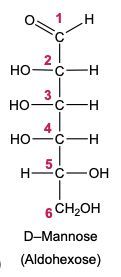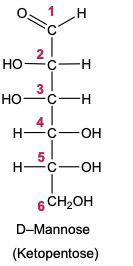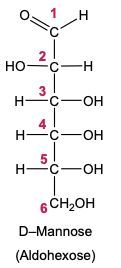Now when it comes to the reduction of an aldose or keto sugar, we're going to say the carbonyl group is reduced via a reducing agent to a hydroxyl group to create a sugar alcohol. Now when I say hydroxyl group, I just mean an OH group. A sugar alcohol is just a monosaccharide that has all carbons connected to a hydroxyl group. Now when it comes to this reduction, the reducing agent is H2, and the reduction is facilitated by the use of a metal catalyst in the form of nickel, platinum, or palladium. What happens in this reaction is that our carbonyl oxygen gains an H, and the carbonyl carbon also gains an H. So we go from an aldose or keto sugar to our sugar alcohol.
- 1. Matter and Measurements4h 29m
- What is Chemistry?5m
- The Scientific Method9m
- Classification of Matter16m
- States of Matter8m
- Physical & Chemical Changes19m
- Chemical Properties8m
- Physical Properties5m
- Intensive vs. Extensive Properties13m
- Temperature (Simplified)9m
- Scientific Notation13m
- SI Units (Simplified)5m
- Metric Prefixes24m
- Significant Figures (Simplified)11m
- Significant Figures: Precision in Measurements7m
- Significant Figures: In Calculations19m
- Conversion Factors (Simplified)15m
- Dimensional Analysis22m
- Density12m
- Specific Gravity9m
- Density of Geometric Objects19m
- Density of Non-Geometric Objects9m
- 2. Atoms and the Periodic Table5h 23m
- The Atom (Simplified)9m
- Subatomic Particles (Simplified)12m
- Isotopes17m
- Ions (Simplified)22m
- Atomic Mass (Simplified)17m
- Atomic Mass (Conceptual)12m
- Periodic Table: Element Symbols6m
- Periodic Table: Classifications11m
- Periodic Table: Group Names8m
- Periodic Table: Representative Elements & Transition Metals7m
- Periodic Table: Elemental Forms (Simplified)6m
- Periodic Table: Phases (Simplified)8m
- Law of Definite Proportions9m
- Atomic Theory9m
- Rutherford Gold Foil Experiment9m
- Wavelength and Frequency (Simplified)5m
- Electromagnetic Spectrum (Simplified)11m
- Bohr Model (Simplified)9m
- Emission Spectrum (Simplified)3m
- Electronic Structure4m
- Electronic Structure: Shells5m
- Electronic Structure: Subshells4m
- Electronic Structure: Orbitals11m
- Electronic Structure: Electron Spin3m
- Electronic Structure: Number of Electrons4m
- The Electron Configuration (Simplified)22m
- Electron Arrangements5m
- The Electron Configuration: Condensed4m
- The Electron Configuration: Exceptions (Simplified)12m
- Ions and the Octet Rule9m
- Ions and the Octet Rule (Simplified)8m
- Valence Electrons of Elements (Simplified)5m
- Lewis Dot Symbols (Simplified)7m
- Periodic Trend: Metallic Character4m
- Periodic Trend: Atomic Radius (Simplified)7m
- 3. Ionic Compounds2h 18m
- Periodic Table: Main Group Element Charges12m
- Periodic Table: Transition Metal Charges6m
- Periodic Trend: Ionic Radius (Simplified)5m
- Periodic Trend: Ranking Ionic Radii8m
- Periodic Trend: Ionization Energy (Simplified)9m
- Periodic Trend: Electron Affinity (Simplified)8m
- Ionic Bonding6m
- Naming Monoatomic Cations6m
- Naming Monoatomic Anions5m
- Polyatomic Ions25m
- Naming Ionic Compounds11m
- Writing Formula Units of Ionic Compounds7m
- Naming Ionic Hydrates6m
- Naming Acids18m
- 4. Molecular Compounds2h 18m
- Covalent Bonds6m
- Naming Binary Molecular Compounds6m
- Molecular Models4m
- Bonding Preferences6m
- Lewis Dot Structures: Neutral Compounds (Simplified)8m
- Multiple Bonds4m
- Multiple Bonds (Simplified)6m
- Lewis Dot Structures: Multiple Bonds10m
- Lewis Dot Structures: Ions (Simplified)8m
- Lewis Dot Structures: Exceptions (Simplified)12m
- Resonance Structures (Simplified)5m
- Valence Shell Electron Pair Repulsion Theory (Simplified)4m
- Electron Geometry (Simplified)8m
- Molecular Geometry (Simplified)11m
- Bond Angles (Simplified)11m
- Dipole Moment (Simplified)15m
- Molecular Polarity (Simplified)7m
- 5. Classification & Balancing of Chemical Reactions3h 17m
- Chemical Reaction: Chemical Change5m
- Law of Conservation of Mass5m
- Balancing Chemical Equations (Simplified)13m
- Solubility Rules16m
- Molecular Equations18m
- Types of Chemical Reactions12m
- Complete Ionic Equations18m
- Calculate Oxidation Numbers15m
- Redox Reactions17m
- Spontaneous Redox Reactions8m
- Balancing Redox Reactions: Acidic Solutions17m
- Balancing Redox Reactions: Basic Solutions17m
- Balancing Redox Reactions (Simplified)13m
- Galvanic Cell (Simplified)16m
- 6. Chemical Reactions & Quantities2h 35m
- 7. Energy, Rate and Equilibrium3h 46m
- Nature of Energy6m
- First Law of Thermodynamics7m
- Endothermic & Exothermic Reactions7m
- Bond Energy14m
- Thermochemical Equations12m
- Heat Capacity19m
- Thermal Equilibrium (Simplified)8m
- Hess's Law23m
- Rate of Reaction11m
- Energy Diagrams12m
- Chemical Equilibrium7m
- The Equilibrium Constant14m
- Le Chatelier's Principle23m
- Solubility Product Constant (Ksp)17m
- Spontaneous Reaction10m
- Entropy (Simplified)9m
- Gibbs Free Energy (Simplified)18m
- 8. Gases, Liquids and Solids3h 25m
- Pressure Units6m
- Kinetic Molecular Theory14m
- The Ideal Gas Law18m
- The Ideal Gas Law Derivations13m
- The Ideal Gas Law Applications6m
- Chemistry Gas Laws16m
- Chemistry Gas Laws: Combined Gas Law12m
- Standard Temperature and Pressure14m
- Dalton's Law: Partial Pressure (Simplified)13m
- Gas Stoichiometry18m
- Intermolecular Forces (Simplified)19m
- Intermolecular Forces and Physical Properties11m
- Atomic, Ionic and Molecular Solids10m
- Heating and Cooling Curves30m
- 9. Solutions4h 10m
- Solutions6m
- Solubility and Intermolecular Forces18m
- Solutions: Mass Percent6m
- Percent Concentrations10m
- Molarity18m
- Osmolarity15m
- Parts per Million (ppm)13m
- Solubility: Temperature Effect8m
- Intro to Henry's Law4m
- Henry's Law Calculations12m
- Dilutions12m
- Solution Stoichiometry14m
- Electrolytes (Simplified)13m
- Equivalents11m
- Molality15m
- The Colligative Properties15m
- Boiling Point Elevation16m
- Freezing Point Depression9m
- Osmosis16m
- Osmotic Pressure9m
- 10. Acids and Bases3h 29m
- Acid-Base Introduction11m
- Arrhenius Acid and Base6m
- Bronsted Lowry Acid and Base18m
- Acid and Base Strength17m
- Ka and Kb12m
- The pH Scale19m
- Auto-Ionization9m
- pH of Strong Acids and Bases9m
- Acid-Base Equivalents14m
- Acid-Base Reactions7m
- Gas Evolution Equations (Simplified)6m
- Ionic Salts (Simplified)23m
- Buffers25m
- Henderson-Hasselbalch Equation16m
- Strong Acid Strong Base Titrations (Simplified)10m
- 11. Nuclear Chemistry56m
- BONUS: Lab Techniques and Procedures1h 38m
- BONUS: Mathematical Operations and Functions47m
- 12. Introduction to Organic Chemistry1h 34m
- 13. Alkenes, Alkynes, and Aromatic Compounds2h 12m
- 14. Compounds with Oxygen or Sulfur1h 6m
- 15. Aldehydes and Ketones1h 1m
- 16. Carboxylic Acids and Their Derivatives1h 11m
- 17. Amines38m
- 18. Amino Acids and Proteins1h 51m
- 19. Enzymes1h 37m
- 20. Carbohydrates1h 46m
- Intro to Carbohydrates4m
- Classification of Carbohydrates4m
- Fischer Projections4m
- Enantiomers vs Diastereomers8m
- D vs L Enantiomers8m
- Cyclic Hemiacetals8m
- Intro to Haworth Projections4m
- Cyclic Structures of Monosaccharides11m
- Mutarotation4m
- Reduction of Monosaccharides10m
- Oxidation of Monosaccharides7m
- Glycosidic Linkage14m
- Disaccharides7m
- Polysaccharides7m
- 21. The Generation of Biochemical Energy2h 8m
- 22. Carbohydrate Metabolism2h 22m
- 23. Lipids2h 26m
- Intro to Lipids6m
- Fatty Acids25m
- Physical Properties of Fatty Acids6m
- Waxes4m
- Triacylglycerols12m
- Triacylglycerol Reactions: Hydrogenation8m
- Triacylglycerol Reactions: Hydrolysis13m
- Triacylglycerol Reactions: Oxidation7m
- Glycerophospholipids15m
- Sphingomyelins13m
- Steroids15m
- Cell Membranes7m
- Membrane Transport10m
- 24. Lipid Metabolism1h 45m
- 25. Protein and Amino Acid Metabolism1h 37m
- 26. Nucleic Acids and Protein Synthesis2h 54m
- Intro to Nucleic Acids4m
- Nitrogenous Bases16m
- Nucleoside and Nucleotide Formation9m
- Naming Nucleosides and Nucleotides13m
- Phosphodiester Bond Formation7m
- Primary Structure of Nucleic Acids11m
- Base Pairing10m
- DNA Double Helix6m
- Intro to DNA Replication20m
- Steps of DNA Replication11m
- Types of RNA10m
- Overview of Protein Synthesis4m
- Transcription: mRNA Synthesis9m
- Processing of pre-mRNA5m
- The Genetic Code6m
- Introduction to Translation7m
- Translation: Protein Synthesis18m
Reduction of Monosaccharides - Online Tutor, Practice Problems & Exam Prep
 Created using AI
Created using AIThe reduction of aldose or keto sugars involves converting the carbonyl group into a hydroxyl group, resulting in sugar alcohols. This process uses hydrogen (H2) as a reducing agent, facilitated by metal catalysts like nickel, platinum, or palladium. The carbonyl carbon and oxygen each gain an H atom, transforming the sugar structure. Sugar alcohols are named by changing the suffix from -ose to -itol. Understanding this reduction is essential for grasping carbohydrate metabolism and the properties of these compounds in biological systems.
Reduction of Monosaccharides Concept 1
Video transcript
Reduction of Monosaccharides Concept 2
Video transcript
So, let's look and see what this reduction of monosaccharides would resemble. If we take a look here, we have an Aldo sugar to begin with, and we're going to say we're reducing it with H2 with one of our metal catalysts, nickel, palladium, or platinum. Remember, the carbonyl carbon will gain an H, and this carbonyl oxygen is still present, and it also gains an H. And in that way, we've gone from an Aldo sugar to just a sugar alcohol. Now, let's look at our keto sugar. Same thing. We're using H2 with one of our three metal catalysts. We're going to say here that our carbonyl carbon gains an H, and then the carbonyl oxygen is still present, it also gains an H. And again, we've created a sugar alcohol, this time from a ketose sugar. So remember, we're making sugar alcohols because now all the carbons within this structure have an OH connected to it. Right? So just keep that in mind. We're going from an Aldo sugar to a keto sugar. Our carbonyl group is being transformed into a COH group.
Reduction of Monosaccharides Example 1
Video transcript
Here it says determine the sugar alcohol product formed from the reduction of the following monosaccharide. So here's our monosaccharide, which is a keto sugar. Remember, in its reduction, it's the carbonyl carbon or the carbonyl group that's being transformed. We're going to say here that that carbonyl carbon gains an H, and the carbonyl oxygen is still there, it also gains an H. And then the rest of the structure stays the same. So we'd still have this C with an H here and an OH here, this C with an OH here and an H here, and then our CH2OH group. So this would be our sugar alcohol product formed from the reduction of this ketose sugar.
Determine which aldose reactant should be used to produce the following sugar alcohol.
Common Naming of Sugar Alcohols Concept 3
Video transcript
We know the reduction of an aldose or keto sugar creates a sugar alcohol. With this, we have to be able to name these sugar alcohols. Now we're going to say the common naming of sugar alcohols is that the set of rules for naming them are similar to aldose and keto sugars. The way we do it is we modify the ending of our aldose or keto sugars, which typically end with "os", and we change it to "-itol." All because it's an alcohol. So remember, when we have an aldose or keto sugar, their ending is "os". When they get reduced to a sugar alcohol, the ending transforms to "itol".
Reduction of Monosaccharides Example 2
Video transcript
Here it says, "Provide the structure and common name for the sugar alcohol created from the reduction reaction." So, we're starting out with D-ribose. We know that when it comes to reduction, we're reducing the aldehyde group. Now remember the aldehyde group is C double bond O connected to an H. When it comes to reduction, the carbonyl carbon would gain an H and the carbonyl oxygen, which is still there, would also gain an H. This would transform the aldehyde group into a CH2OH group. So we're gonna have CH2OH now, and the rest of the structure would stay the same. So, we'd still have this carbon connected to OHH, and the same with the others. And then CH2OH here on the bottom. Remember, when it comes to naming the common naming of sugar alcohols, we change the 'ose' ending to 'itol.' So, this would be called D-ribitol. This would be the common name of this sugar alcohol.
What is the common name of the sugar alcohol produced when D-galactose is reduced?
L-galactose
D-galactitol
D-galactaric acid
L-galactitol
Draw the Fischer projection for the reduction product of D-mannose, the C-2 epimer of glucose. What is the structure and common name of the sugar alcohol produced?
Do you want more practice?
Here’s what students ask on this topic:
What is the process of reducing aldose and keto sugars?
The reduction of aldose and keto sugars involves converting the carbonyl group (C=O) into a hydroxyl group (OH), resulting in sugar alcohols. This process uses hydrogen (H2) as a reducing agent, facilitated by metal catalysts like nickel, platinum, or palladium. During the reaction, the carbonyl carbon and oxygen each gain an H atom, transforming the sugar structure. For example, an aldose or ketose sugar is reduced to a sugar alcohol, where all carbons are connected to hydroxyl groups. This transformation is crucial for understanding carbohydrate metabolism and the properties of these compounds in biological systems.
 Created using AI
Created using AIWhat are the common catalysts used in the reduction of monosaccharides?
The common catalysts used in the reduction of monosaccharides are metals such as nickel (Ni), platinum (Pt), and palladium (Pd). These catalysts facilitate the reduction process by enabling the hydrogen (H2) to effectively add to the carbonyl group of the sugar, converting it into a hydroxyl group. This results in the formation of sugar alcohols from aldose or ketose sugars. The choice of catalyst can influence the efficiency and specificity of the reduction reaction.
 Created using AI
Created using AIHow are sugar alcohols named after the reduction of aldose or keto sugars?
Sugar alcohols are named by modifying the suffix of the original aldose or ketose sugar. Typically, aldose and ketose sugars end with the suffix -ose. When these sugars are reduced to sugar alcohols, the suffix changes to -itol. For example, glucose (an aldose) becomes glucitol, and fructose (a ketose) becomes fructitol. This naming convention helps in identifying the compound as a sugar alcohol, which is important for understanding its chemical properties and biological functions.
 Created using AI
Created using AIWhat is the role of hydrogen in the reduction of monosaccharides?
Hydrogen (H2) acts as the reducing agent in the reduction of monosaccharides. During the reaction, hydrogen atoms are added to the carbonyl group of the sugar. Specifically, the carbonyl carbon gains one hydrogen atom, and the carbonyl oxygen gains another hydrogen atom. This addition converts the carbonyl group (C=O) into a hydroxyl group (OH), resulting in the formation of a sugar alcohol. The presence of a metal catalyst like nickel, platinum, or palladium facilitates this hydrogenation process.
 Created using AI
Created using AIWhat is the significance of sugar alcohols in biological systems?
Sugar alcohols play a significant role in biological systems due to their unique properties. They are often used as low-calorie sweeteners in food products because they provide sweetness without the same caloric content as regular sugars. Additionally, sugar alcohols do not cause a rapid spike in blood glucose levels, making them suitable for diabetic-friendly diets. In metabolism, sugar alcohols can be intermediates in various biochemical pathways, contributing to energy production and storage. Understanding their formation and function is essential for studying carbohydrate metabolism and nutrition.
 Created using AI
Created using AIYour GOB Chemistry tutor
- Reduction of d-fructose with a reducing agent yields a mixture of d-sorbitol along with a second, isomeric pro...
- Treatment of d-glucose with a reducing agent yields sorbitol, a substance used as a sugar substitute by people...
- Use the Fischer projection for d-gulose in problem 13.69 to answer each of the following: (13.3, 13.5)a. Draw ...
- ALLIED Health The sugar alcohol ribitol is a component of the vitamin riboflavin and the energy transfer molec...
- ALLIED Health The sugar alcohol erythritol is often included in low-calorie sweeteners. It is 70% as sweet as ...
